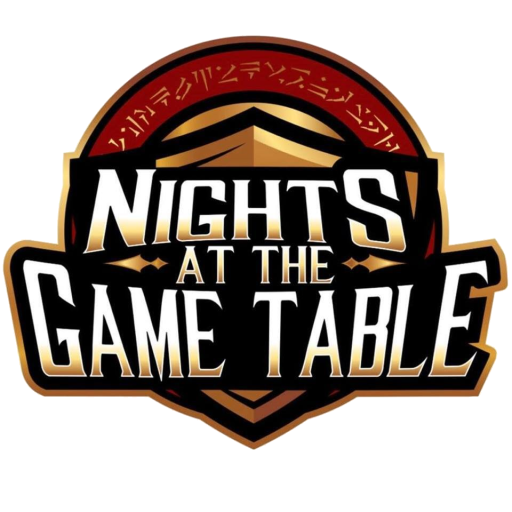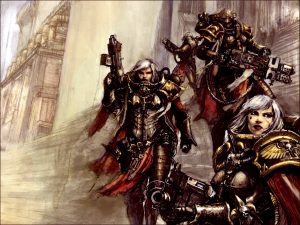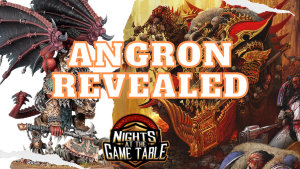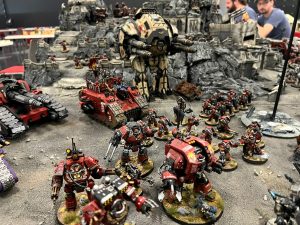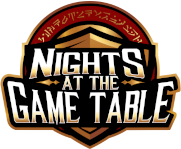Good morning ladies and gentlemen! Do I have quite the surprise for you. Last week I was chatting to my good friend and teammate Justin Cook from Beast Coast, and pitched an idea to him. The idea was a cultural exchange of sorts, but instead of exchanging our heritage, we’re exchanging our 40k armies. Justin is a notorious Tay payer who’s seen a lot of success over the past year with them, while I’ve been knee deep in Genestealer Cult learning all their nuances, even boasting a tournament record of 21-1 across 4 GT’s/Majors. So, what better way to throw caution to the wind and throw out months of practice then to pick up an army you’ve played exactly 0 times before and take it to a major?
That’s right, I’ll be playing Tau at the Summer Slaughter major GT! This will be an exceptionally hard major as well, with multiple heavy hitttrs such as TJ Lanigan and Andrew Gonyo in attendance too. But, of course I can’t just play a copy and pasted Tau army (though admittedly I ended up with a pretty standard build, save for some special brown magic). So, in today’s article I wanted to take a moment to show you exactly the idea behind my list, how I arrived at the choices I did, and how I want to make it work.

I used my own personal coaching method on myself to start, so instead of designing an army to start, I began by analyzing the NOVA missions. NOVA is a mildly different format than ITC, but the few differences they do have create a cascading impact on the way you can design a list. Most notably, the primary missions are different. Where ITC rewards you for creating a board control army, so you can easily get the points for “hold more”, NOVA allows you a bit of wiggle room as they have an optional end game component. This allows you to forfeit the board entirely in the early game, provided you can actually make up for it on turn 6. This means there will be no senseless killing of random tau units as they try to compete for “hold more”. Another enormous difference is the lack of concept of “kill more”. ITC rewards you for killing more units than your opponent in a battle round, and conversely this punishes you for taking multiple, small, easy to kill units *cough 2 man drones cough*. All of Tau’s support drones except for units of actual tactical drones can only really be taken in the form of two man units. This is an enormous liability for tau players in ITC because it gives up “kill more” repeatedly, thankfully this is not a fear in NOVA.

The secondaries for NOVA and ITC are for the most part similar, but there are some key differences that are noteworthy for Tau. Moment of bloodshed in NOVA (their equivalent of butchers bill) has been changed to earning one point for killing 3 units in any battle round, whereas in ITC it’s 2 in a game turn. Needless to say killing 3 units every round consistently is substantially harder than killing 2 in any turn. Those two man drones which would give up kill more in ITC, would also likely give up max butchers bill, however there’s a bit more breathing room in NOVA for that. Another subtle yet major change between NOVA and ITC is how they do recon. In ITC recon is scored when at least one model from a unit is partially in every quarter. This makes it incredibly easy to score for large units, because one unit can straddle multiple quarters and choose which one it counts for as needed, where in NOVA a unit must be entirely in a quarter to count, meaning that same unit would actually count for neither. NOVA actually rewards having tons of small units which can easily hop into quarters- again, see the humble two man drone. Finally, NOVA has an entirely unique secondary called strike the rank and file. For this secondary you earn 1 point for every 25% of your opponents troop units you destroy, and if your opponent doesn’t have any it’s a free 4 points. Tau troops are an enormous liability, because they’re slow compared to the rest of the army, and they don’t have fly which makes them vulnerable to being hugged. However, NOVA all but forces you to take at least some troops to make your opponent work for this one.
The last big difference between NOVA and ITC is the terrain layout. Every table is the same with two enormous line of sight blocking L-shaped ruins in the middle. This is a huge detriment to the classic tau builds for multiple reasons. First, they obviously block line of sight, and tau being an entirely shooting based army (traditionally) do not appreciate this. Second, traditional Tau armies played properly actually like to run into the middle of the table with and set up camp, that way they can mitigate the weakness of their relatively low range. This is much more difficult with two middle los blockers, and a tournament rule saying you cannot go on top of the ruins even with fly.

With all this in mind, I needed to change my thinking in regards to Tau’s playstyle in a NOVA format event. I decided mobility and range are going to be key to maneuver around the L’s. I think the classic style of “un-chargeable castle” Tau simply won’t work. Opposing armies can hide behind the L’s racking up points on progressive primaries and simply outlast the Tau army without lifting a finger. To this end I’ve decided to focus on a tau build with more maneuverability. This meant popular but static units like broadsides hade no place in my army. Additionally, I’ve opted to put target locks on two of my riptides over velocity trackers. This may be a highly controversial choice due the prevalence of flier spam and how brutal that match up can be, but I think it’s a necessary change to handle the L’s. I’m hoping the freedom awarded from being able to take two man drones without being punished by the mission has allowed me to increase my overall shield drone count to help compensate. I also opted for triple cold stars with quad missile pods instead of more common builds like enforcers with cyclic ions. The logic here being that if I’m playing a mobile Tau army that is theoretically too spread out to get insane supporting fire overwatches I’ll need to mitigate the combat weakness by simply being further away from the enemy, thus the missile pods became the clear choice as they had the longest range. They’re also rather useful vs Eldar/DE fliers as they have identical range to the planes (whereas cyclic ions would only work if the planes move towards them), and the S7 is gold against the T6 planes. This was a big selling point since I’m opting out of velocity trackers on riptides. Finally, Daemons + TS are an enormous hurdle for Tau to climb because of the hit modifiers an targeted smites bypassing savior protocols, not to mention it’s one of the most successful lists out there right now. Having commanders that at worst hit plagubearers on 4’s (and will probably hit them on 3’s or even 2’s rerolling 1’s) that can shoot multi damage shots from out of retaliation range seems very useful in that match as well, whereas cyclic commanders may just end up shooting once and then dying.

With all that in mind, I got to work constructing a list, and I’ll be playing it for the first time tomorrow on stream for Nights PRO members only. I’ll be playing against my local testing partner and 3rd place finisher at BAO Jack Harpster and his GSC. Jack’s been working on an alternative style build for GSC so it should lead to a very interesting game. This will be my only practice game before The Summer Slaughter this weekend, where I’ll see if I can really take an army I’ve literally never played before and win a major with it!
The stream will be Thursday July 25th at 5:30pm EST, and here are the lists we will be using
| Nick Nanavati | Jack Harpster | |||
| Tau Battalion | GSC battalion | |||
| Coldstar- 4 missile pods, 2 shield drones | 170 | Magus <4ae> | 80 | |
| Cadre Fireblade- 2 shield drones | 62 | Primus <twisted helix> | 75 | |
| Cadre Fireblade- 2 shield drones | 62 | 10 brrod brothers | 40 | |
| 5 Fire Warriors- 2 shield drones | 55 | 10 brrod brothers | 40 | |
| 5 Fire Warriors- 2 shield drones | 55 | 15 Acolytes- 4 rock saws , banner <twisted helix> | 155 | |
| 5 Fire Warriors- shield drones | 55 | 10 Aberrants- 8 piscks, 2 stop signs <twisted helix> | 252 | |
| 10 Aberrants- 8 piscks, 2 stop signs <twisted helix> | 252 | |||
| Coldstar- 4 missile pods, 2 shield drones | 170 | Clamavaus <twisted helix> | 55 | |
| Darkstrider | 45 | Nexos <twisted helix> | 50 | |
| 6 Shield Drones | 60 | Kelermorph <4ae> | 60 | |
| 6 Shield Drones | 60 | |||
| 6 Shield Drones | 60 | Rusted Claw Battalion | ||
| Magus- familiar (crouchling) | 92 | |||
| Tau Vanguard | Alphus | 70 | ||
| Coldstar- 4 missile pods, 2 shield drones | 170 | 10 Neophytes- 2 webbers, web pistol | 53 | |
| Cadre Fireblade- 2 shield drones | 62 | 10 Neophytes- 2 webbers, web pistol | 53 | |
| Marksmen | 25 | 10 Neophytes- 2 webbers, web pistol | 53 | |
| Marksmen | 25 | Kelermorph | 60 | |
| Marksmen | 25 | |||
| Riptide- Burst Cannon, SMS, ATS, Target Lock | 280 | Rusted Claw Battalion | ||
| Riptide- Burst Cannon, SMS, ATS, Target Lock | 280 | Patriarch | 125 | |
| Riptide- Burst Cannon, SMS, ATS, Velociity Tracker | 278 | Alphus | 70 | |
| 10 Neophytes- 2 webbers, web pistol | 53 | |||
| 10 Neophytes- 2 webbers, web pistol | 53 | |||
| 10 Neophytes- 2 webbers, web pistol | 53 | |||
| 5 Jackals- 5 demo charges | 75 | |||
| 5 jackals- 1 grenade/shotgun, 3x 2 pistols, sergeant with auto gun/shotgun, quad bike with heavy stubber, shotgun | 70 | |||
| Kelermorph | 60 |
If you liked this kind of breakdown and analysis let me know and I’ll try to do more of them! And of course, if you if you want to have your own army analyzed ad receive this kind of coaching for yourself you can sign up here
